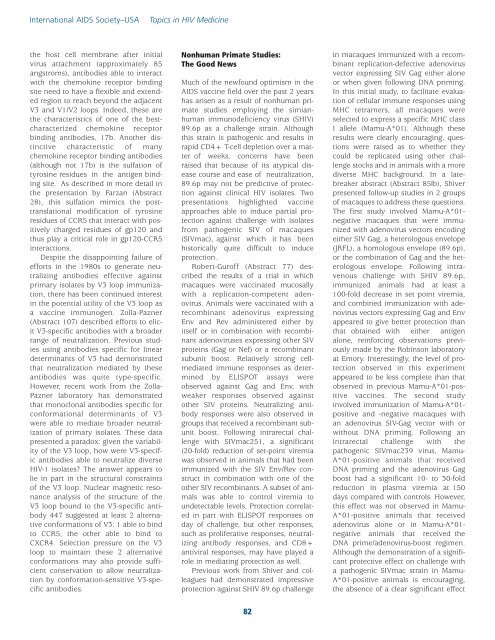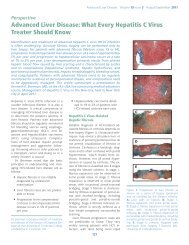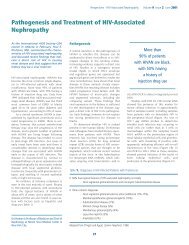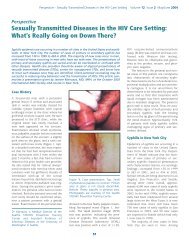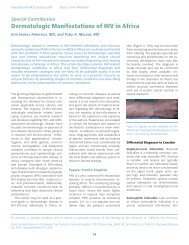Topics in HIV Medicine® - International AIDS Society-USA
Topics in HIV Medicine® - International AIDS Society-USA
Topics in HIV Medicine® - International AIDS Society-USA
Create successful ePaper yourself
Turn your PDF publications into a flip-book with our unique Google optimized e-Paper software.
<strong>International</strong> <strong>AIDS</strong> <strong>Society</strong>–<strong>USA</strong><br />
<strong>Topics</strong> <strong>in</strong> <strong>HIV</strong> Medic<strong>in</strong>e<br />
the host cell membrane after <strong>in</strong>itial<br />
virus attachment (approximately 85<br />
angstroms), antibodies able to <strong>in</strong>teract<br />
with the chemok<strong>in</strong>e receptor b<strong>in</strong>d<strong>in</strong>g<br />
site need to have a flexible and extended<br />
region to reach beyond the adjacent<br />
V3 and V1/V2 loops. Indeed, these are<br />
the characteristics of one of the bestcharacterized<br />
chemok<strong>in</strong>e receptor<br />
b<strong>in</strong>d<strong>in</strong>g antibodies, 17b. Another dist<strong>in</strong>ctive<br />
characteristic of many<br />
chemok<strong>in</strong>e receptor b<strong>in</strong>d<strong>in</strong>g antibodies<br />
(although not 17b) is the sulfation of<br />
tyros<strong>in</strong>e residues <strong>in</strong> the antigen b<strong>in</strong>d<strong>in</strong>g<br />
site. As described <strong>in</strong> more detail <strong>in</strong><br />
the presentation by Farzan (Abstract<br />
28), this sulfation mimics the posttranslational<br />
modification of tyros<strong>in</strong>e<br />
residues of CCR5 that <strong>in</strong>teract with positively<br />
charged residues of gp120 and<br />
thus play a critical role <strong>in</strong> gp120-CCR5<br />
<strong>in</strong>teractions.<br />
Despite the disappo<strong>in</strong>t<strong>in</strong>g failure of<br />
efforts <strong>in</strong> the 1980s to generate neutraliz<strong>in</strong>g<br />
antibodies effective aga<strong>in</strong>st<br />
primary isolates by V3 loop immunization,<br />
there has been cont<strong>in</strong>ued <strong>in</strong>terest<br />
<strong>in</strong> the potential utility of the V3 loop as<br />
a vacc<strong>in</strong>e immunogen. Zolla-Pazner<br />
(Abstract 107) described efforts to elicit<br />
V3-specific antibodies with a broader<br />
range of neutralization. Previous studies<br />
us<strong>in</strong>g antibodies specific for l<strong>in</strong>ear<br />
determ<strong>in</strong>ants of V3 had demonstrated<br />
that neutralization mediated by these<br />
antibodies was quite type-specific.<br />
However, recent work from the Zolla-<br />
Pazner laboratory has demonstrated<br />
that monoclonal antibodies specific for<br />
conformational determ<strong>in</strong>ants of V3<br />
were able to mediate broader neutralization<br />
of primary isolates. These data<br />
presented a paradox: given the variability<br />
of the V3 loop, how were V3-specific<br />
antibodies able to neutralize diverse<br />
<strong>HIV</strong>-1 isolates The answer appears to<br />
lie <strong>in</strong> part <strong>in</strong> the structural constra<strong>in</strong>ts<br />
of the V3 loop. Nuclear magnetic resonance<br />
analysis of the structure of the<br />
V3 loop bound to the V3-specific antibody<br />
447 suggested at least 2 alternative<br />
conformations of V3: 1 able to b<strong>in</strong>d<br />
to CCR5, the other able to b<strong>in</strong>d to<br />
CXCR4. Selection pressure on the V3<br />
loop to ma<strong>in</strong>ta<strong>in</strong> these 2 alternative<br />
conformations may also provide sufficient<br />
conservation to allow neutralization<br />
by conformation-sensitive V3-specific<br />
antibodies.<br />
Nonhuman Primate Studies:<br />
The Good News<br />
Much of the newfound optimism <strong>in</strong> the<br />
<strong>AIDS</strong> vacc<strong>in</strong>e field over the past 2 years<br />
has arisen as a result of nonhuman primate<br />
studies employ<strong>in</strong>g the simianhuman<br />
immunodeficiency virus (S<strong>HIV</strong>)<br />
89.6p as a challenge stra<strong>in</strong>. Although<br />
this stra<strong>in</strong> is pathogenic and results <strong>in</strong><br />
rapid CD4+ T-cell depletion over a matter<br />
of weeks, concerns have been<br />
raised that because of its atypical disease<br />
course and ease of neutralization,<br />
89.6p may not be predictive of protection<br />
aga<strong>in</strong>st cl<strong>in</strong>ical <strong>HIV</strong> isolates. Two<br />
presentations highlighted vacc<strong>in</strong>e<br />
approaches able to <strong>in</strong>duce partial protection<br />
aga<strong>in</strong>st challenge with isolates<br />
from pathogenic SIV of macaques<br />
(SIVmac), aga<strong>in</strong>st which it has been<br />
historically quite difficult to <strong>in</strong>duce<br />
protection.<br />
Robert-Guroff (Abstract 77) described<br />
the results of a trial <strong>in</strong> which<br />
macaques were vacc<strong>in</strong>ated mucosally<br />
with a replication-competent adenovirus.<br />
Animals were vacc<strong>in</strong>ated with a<br />
recomb<strong>in</strong>ant adenovirus express<strong>in</strong>g<br />
Env and Rev adm<strong>in</strong>istered either by<br />
itself or <strong>in</strong> comb<strong>in</strong>ation with recomb<strong>in</strong>ant<br />
adenoviruses express<strong>in</strong>g other SIV<br />
prote<strong>in</strong>s (Gag or Nef) or a recomb<strong>in</strong>ant<br />
subunit boost. Relatively strong cellmediated<br />
immune responses as determ<strong>in</strong>ed<br />
by ELISPOT assays were<br />
observed aga<strong>in</strong>st Gag and Env, with<br />
weaker responses observed aga<strong>in</strong>st<br />
other SIV prote<strong>in</strong>s. Neutraliz<strong>in</strong>g antibody<br />
responses were also observed <strong>in</strong><br />
groups that received a recomb<strong>in</strong>ant subunit<br />
boost. Follow<strong>in</strong>g <strong>in</strong>trarectal challenge<br />
with SIVmac251, a significant<br />
(20-fold) reduction of set-po<strong>in</strong>t viremia<br />
was observed <strong>in</strong> animals that had been<br />
immunized with the SIV Env/Rev construct<br />
<strong>in</strong> comb<strong>in</strong>ation with one of the<br />
other SIV recomb<strong>in</strong>ants. A subset of animals<br />
was able to control viremia to<br />
undetectable levels. Protection correlated<br />
<strong>in</strong> part with ELISPOT responses on<br />
day of challenge, but other responses,<br />
such as proliferative responses, neutraliz<strong>in</strong>g<br />
antibody responses, and CD8+<br />
antiviral responses, may have played a<br />
role <strong>in</strong> mediat<strong>in</strong>g protection as well.<br />
Previous work from Shiver and colleagues<br />
had demonstrated impressive<br />
protection aga<strong>in</strong>st S<strong>HIV</strong> 89.6p challenge<br />
<strong>in</strong> macaques immunized with a recomb<strong>in</strong>ant<br />
replication-defective adenovirus<br />
vector express<strong>in</strong>g SIV Gag either alone<br />
or when given follow<strong>in</strong>g DNA prim<strong>in</strong>g.<br />
In this <strong>in</strong>itial study, to facilitate evaluation<br />
of cellular immune responses us<strong>in</strong>g<br />
MHC tetramers, all macaques were<br />
selected to express a specific MHC class<br />
I allele (Mamu-A*01). Although these<br />
results were clearly encourag<strong>in</strong>g, questions<br />
were raised as to whether they<br />
could be replicated us<strong>in</strong>g other challenge<br />
stocks and <strong>in</strong> animals with a more<br />
diverse MHC background. In a latebreaker<br />
abstract (Abstract 85lb), Shiver<br />
presented follow-up studies <strong>in</strong> 2 groups<br />
of macaques to address these questions.<br />
The first study <strong>in</strong>volved Mamu-A*01-<br />
negative macaques that were immunized<br />
with adenovirus vectors encod<strong>in</strong>g<br />
either SIV Gag, a heterologous envelope<br />
(JRFL), a homologous envelope (89.6p),<br />
or the comb<strong>in</strong>ation of Gag and the heterologous<br />
envelope. Follow<strong>in</strong>g <strong>in</strong>travenous<br />
challenge with S<strong>HIV</strong> 89.6p,<br />
immunized animals had at least a<br />
100-fold decrease <strong>in</strong> set po<strong>in</strong>t viremia,<br />
and comb<strong>in</strong>ed immunization with adenovirus<br />
vectors express<strong>in</strong>g Gag and Env<br />
appeared to give better protection than<br />
that obta<strong>in</strong>ed with either antigen<br />
alone, re<strong>in</strong>forc<strong>in</strong>g observations previously<br />
made by the Rob<strong>in</strong>son laboratory<br />
at Emory. Interest<strong>in</strong>gly, the level of protection<br />
observed <strong>in</strong> this experiment<br />
appeared to be less complete than that<br />
observed <strong>in</strong> previous Mamu-A*01-positive<br />
vacc<strong>in</strong>es. The second study<br />
<strong>in</strong>volved immunization of Mamu-A*01-<br />
positive and -negative macaques with<br />
an adenovirus SIV-Gag vector with or<br />
without DNA prim<strong>in</strong>g. Follow<strong>in</strong>g an<br />
<strong>in</strong>trarectal challenge with the<br />
pathogenic SIVmac239 virus, Mamu-<br />
A*01-positive animals that received<br />
DNA prim<strong>in</strong>g and the adenovirus Gag<br />
boost had a significant 10- to 30-fold<br />
reduction <strong>in</strong> plasma viremia at 150<br />
days compared with controls. However,<br />
this effect was not observed <strong>in</strong> Mamu-<br />
A*01-positive animals that received<br />
adenovirus alone or <strong>in</strong> Mamu-A*01-<br />
negative animals that received the<br />
DNA prime/adenovirus-boost regimen.<br />
Although the demonstration of a significant<br />
protective effect on challenge with<br />
a pathogenic SIVmac stra<strong>in</strong> <strong>in</strong> Mamu-<br />
A*01-positive animals is encourag<strong>in</strong>g,<br />
the absence of a clear significant effect<br />
82


